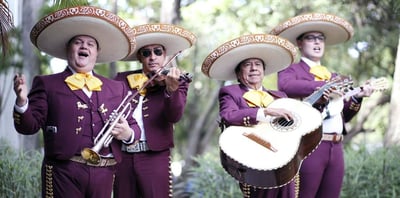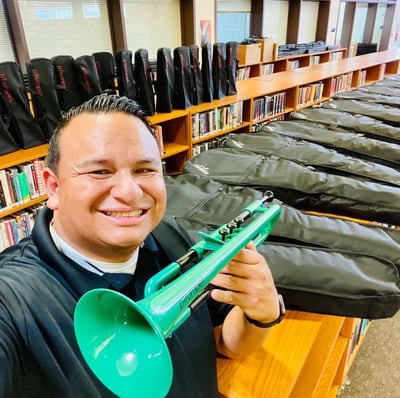Search for topics or resources
Enter your search below and hit enter or click the search icon.
August 23rd, 2022
3 min read
By Ewan Moore

For longtime educator Ramón Rivera, National Hispanic Heritage Month is the perfect time to bring everyone together through the power of music. Specifically, Mariachi.
“I come from a family of teaching musicians,” Ramón tells us. “My mom's Mariachi, my sister, my brothers. We used to play together as a family. When I was in the fourth grade, my mom bought me a trumpet and said: ‘One day you're going to play Mariachi’. She signed me up for the band. And after that, it just took over.”
In the United States, National Hispanic Heritage Month begins on September 15 and runs through October 15. It’s a time to celebrate, but also to learn. It’s a time to embrace new cultures and old traditions, and - in the case of many budding musicians - get involved with some great new styles of music.
“I just started to fall in love with the music because it also related to my culture, my music, and some of the songs that we played. Keeping the art, this art form, alive after more than 100 years? It's just beautiful music.”
“Then I started volunteering with this other teacher who taught me. An older gentleman, Mr. Vasquez, taught me how to play mariachi and how to teach Mariachi. And I learned so much. And then once I started teaching, I saw kids learning. That got me excited to be a teacher. Seeing kids who knew nothing but who are now performing. Seeing their smiles and their joy, and just hearing them and hearing them get in front of an audience, singing or playing…and playing the trumpet.”

Even if you’re not well-versed in the history and details of Mariachi, you’re doubtless familiar with the concept. But dig a little deeper, and you’ll find a rich, wonderful, accessible genre of music that’s deeply rooted in tradition and familial ties that stretch back to the 18th century.
“It came from the western states of Mexico, near Guadalajara, the capital of the state of Jalisco,” Ramón explains of the origins of Mariachi.
A contemporary Mariachi band typically includes the vihuela (a five-string guitar), the guitarrón (a large, fretless six-string bass guitar), a standard six-string acoustic guitar, violins, and trumpets. Interestingly, while trumpets have long been an essential element of Mariachi performances, they weren’t added until the early 20th century.
Ramón continues: “It was just played for weddings, you know, and celebrations. But then it became more commercialized once television came in. So people would dress up. And then it became popular because the TV people said, ‘Oh, we want to have a Mariachi at our celebration’. And it became the national music of Mexico, the heart of Mexico. And now it's spread to the United States, where we have Mariachi programs all over the country.”
While some believe these instruments are only for those who already know how to play, or older students who might already be in music ensembles, starting younger has great benefit to all music programs. Many elementary schools have guitar or even ukulele classes. This is a good start, as Mariachi songs can be adapted for these instruments and students can easily move to traditional mariachi instruments once schools obtain them.
Affordable plastic instruments such as the pTrumpet and even the pBuzz are also a vital part of the mix. These lightweight instruments are easy for younger students, meaning they’re also easier to play for longer. In Mariachi, trumpet players play and sing, making pInstruments an excellent choice. It also gives the students confidence that they can join other music ensembles in future years and find success. 
“This past school year at La Venture Middle School we tried using pTrumpet with 17 beginner Mariachi Students,” Ramón recalls. “We had 40 students sign up for the Mariachi class this year. The majority of the Mount Vernon Middle School students were sixth graders. This past school year we went with the pTrumpet instead of a brass trumpet. A brass trumpet would normally cost $500-$600 for each student in the program, but the pTrumpet was far less in price.”
“I believe every student should have the opportunity to learn the trumpet. This year we got pTrumpets that were the school colors of green and black! The middle school Mariachi students loved how the pTrumpet was lightweight and easy to use, especially. The students went from zero to playing three songs at our Mount Vernon School District Winter Mariachi Festival!
For those teachers who prefer a more elementary-style instrument, the pBuzz is in the key of C (like guitars). With six notes on one partial, it’s the easiest way to begin their brass instrument journey.
"Honestly, I would recommend pIntstruments to any music teacher who happens to be on a budget and wants to have more kids play the trumpet in their program.”
We also spoke with Ramón about why Mariachi is taking schools across the country by storm, and why it's a style of music that's being embraced by everyone. You can read all about it right here.
For more information on how your school can get involved with and embrace Mariachi, please head to the Mariachi page for more information and resources.
After seven years writing about video games, Ewan made the jump to the music instrument industry to stop his family asking when he was going to get a real job. Mostly, though, he adores music and is passionate about its vital role throughout life - especially in education. He also played guitar in several bands with deeply embarrassing names that won't be revealed here. With a degree in journalism from an NCTJ-accredited university under his belt, Ewan uses everything he learned as a writer over the last decade to help answer any questions you might have about pBone Music in an accessible (and hopefully entertaining) way. Because if you can write 1,000 words on SSDs and ray-tracing, you can explain why plastic instruments are accessible, sustainable, and fun.